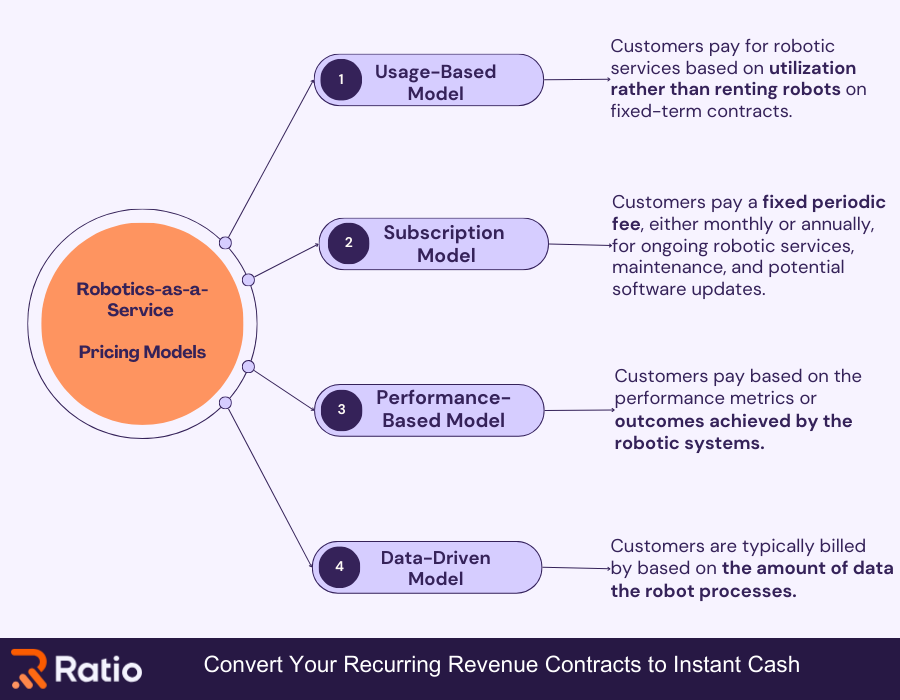Optimizing Robotics-as-a-Service Models for Subscription Economy
The Robotics-as-a-Service (RaaS) model is set to reach a $4 billion market cap by 2028, attracting businesses seeking enhanced productivity and efficiency through robotic automation.
As RaaS gains traction, robotics companies encounter two main challenges: identifying a suitable subscription model and arranging working capital with flexible, subscription-based payment plans to their customers.
In this article, we will discuss how robotics vendors can optimize subscription models for their target customers without affecting cash flow.
Understanding the Robots-as-a-Service Pricing Models
When crafting their RaaS pricing models, vendors can enhance their approach by considering essential factors that align with market needs, competitiveness, and long-term viability.
Key considerations include understanding and catering to customer needs, ensuring scalability and flexibility through adaptable contract terms, embracing technological integration to elevate robotic capabilities, and establishing clear guidelines for maintenance and client support.
Our analysis seeks to identify distinct RaaS models and delves into their advantages and disadvantages, offering valuable insights for RaaS vendors.

- Usage-Based Model
Customers pay for robotic services based on utilization rather than renting robots on fixed-term contracts. Companies such as Diligent Robotics offer such "pay-as-you-go" models.
Pros: This model enhances customer retention with its affordable, usage-based access to robotic features, giving vendors a competitive edge.
Cons: RaaS vendors may experience fluctuations in income depending on customer demand and usage patterns.
- Subscription Model
Customers pay a fixed periodic fee, either monthly or annually, for ongoing robotic services, maintenance, and potential software updates.
Companies like Locus Robotics and Global Robotics Services(GRS) offer RaaS models, allowing customers to subscribe or pay by the hour for their services.
Pros: Predictable revenue for RaaS providers.
Cons: Vendors risk customer churn due to low switching costs and competitors' better value offers.
- Performance-Based Model
A RaaS pricing model where the service charges are tied to the performance metrics or outcomes achieved through robotic systems. For instance, a logistics firm could be billed based on the packages it sorts or delivers.
Hirebotics offers a cloud platform that streamlines robot deployment, emphasizing performance tracking and issue resolution in their RaaS approach.
Pros: Vendors with a performance-based model can distinguish themselves in a crowded market through value-based pricing.
Cons: Revenues can vary due to the ever-changing and industry-specific nature of performance metrics. Also, implementing this model can be complex, requiring thorough tracking and in-depth analysis.
- Data-Driven Model
RaaS providers employing this model typically bill based on the data processed or analyzed by robots. It's common with intelligent robots that gather and process significant amounts of data.
For instance, in the e-commerce sector, robots deployed in warehouses might gather data on inventory movement, item availability, and sales predictions, assisting in streamlining the supply chain and optimizing stock management. These robots analyze patterns to predict stock demand and ensure efficient inventory turnover.
Pros: Data-driven pricing can unlock new revenue streams. Vendors can explore value-added services, such as data analytics insights, training, and customization, which customers may be willing to pay for in addition to their standard RaaS subscriptions.
Cons: Data collection and analysis can trigger privacy issues, particularly with sensitive or personal details. Furthermore, data analytics, storage, and management expenses can elevate operational costs for RaaS vendors.
Overcoming Challenges in RaaS Implementation
Robotics is a capital-intensive industry demanding a substantial investment in manufacturing and research for continuous innovation. However, the cash restraint customers, reluctant to make upfront payments, put robotics vendors in a tight spot. Solutions like hardware financing for robotics OEMs enable vendors to offer devices via subscriptions without overburdening their balance sheets.Moreover, as revenues trickle in gradually over the subscription period, credit risks emerge, especially with late client payments.
That's where strategic revenue-based financing (RBF) can help RaaS vendors by providing immediate access to working capital against future revenues. This approach ensures vendors refrain from tapping into their existing resources or postponing crucial investments in innovation and expansion.
The financing company does the heavy lifting by handling the collection of payments from the vendors’ customers throughout the subscription period while offering vendors immediate funds, often via a true sale structure that transfers receivables and risk, essential for their growth initiatives.This approach also serves customers well by allowing them to make payments as per a subscription plan of their choice.
Another major challenge for RaaS vendors is precisely calibrating their software capabilities to integrate subscription-based payment plans into their offerings. This means incorporating features like automated billing, flexible pricing models, and secure payment gateways.
Securing the right financing partner for your RaaS solutions paves the way to address upfront capital challenges and offer flexible pricing at the point of sale. Here are some factors to help you differentiate a reliable financing partner from a sub-optimal one:
- Flexible Financing Options: A partner with flexible financing terms, including diverse lease structures, subscription models, or revenue-sharing agreements, can better meet your financing needs.
- Industry Experience: A partner with a strong history in the robotics or technology sectors has the potential to offer deep insights into industry-specific challenges and opportunities.
- Transparency: Partners who are transparent and communicate help foster a trustworthy, beneficial relationship.
Introducing Ratio Boost: Your Strategic RaaS Ally
The Ratio Boost RaaS financing platform provides an all-in-one solution to address the cash flow challenges faced by RaaS vendors while providing immense flexibility for subscription-based payments at the point of sale.With Ratio's Buy Now Pay Later (BNPL) feature, RaaS providers can access immediate working capital, with Ratio assuming the underwriting risk while RaaS customers make gradual repayments.

Some additional standout features that make Ratio an ideal financing partner for your RaaS solutions include:
- Payment flexibility replaces discounts for closing deals.
- Complete underwriting risk managed by Ratio.
- Effortless integrations with existing sales workflows.
- Quick approval (within 48 hours) and onboarding.
- Over $400 million in available capital for customer financing.
- Shared cost of financing between RaaS vendors and customers
And a lot more you could find out for yourself by joining the Ratio app today!
Offering RaaS solutions in a highly competitive market is no easy feat as such. Letting Ratio handle your capital and financing essentials could help ease up the load a little.








.png)



